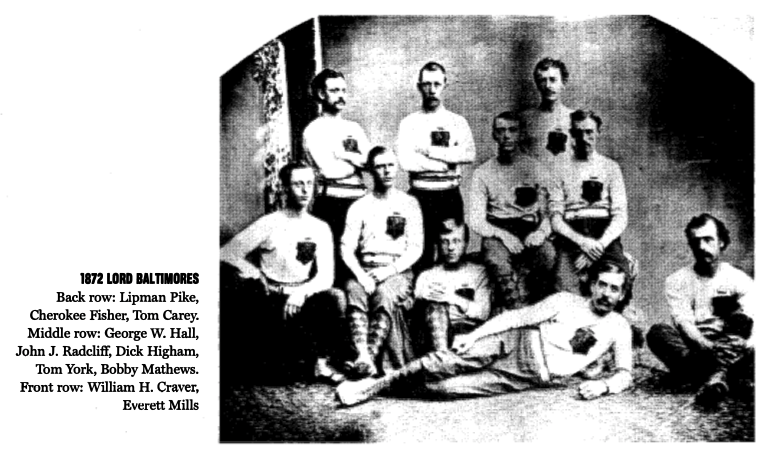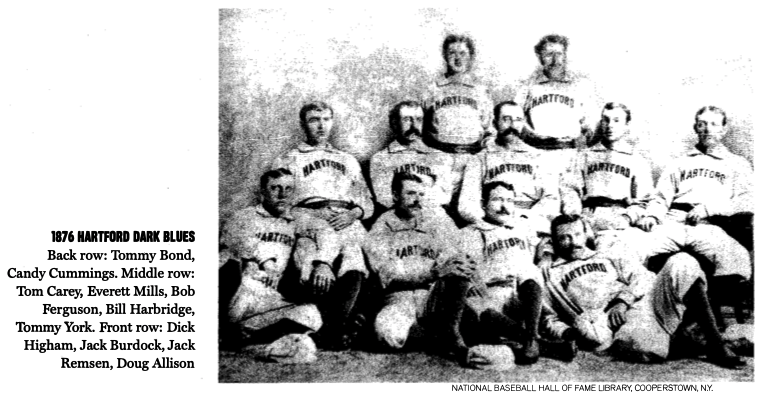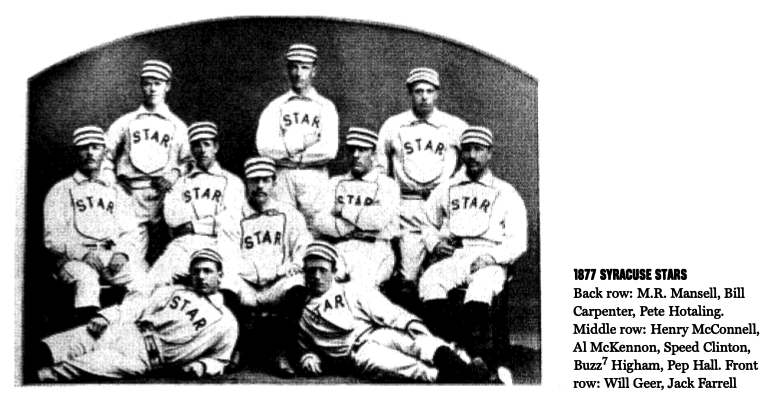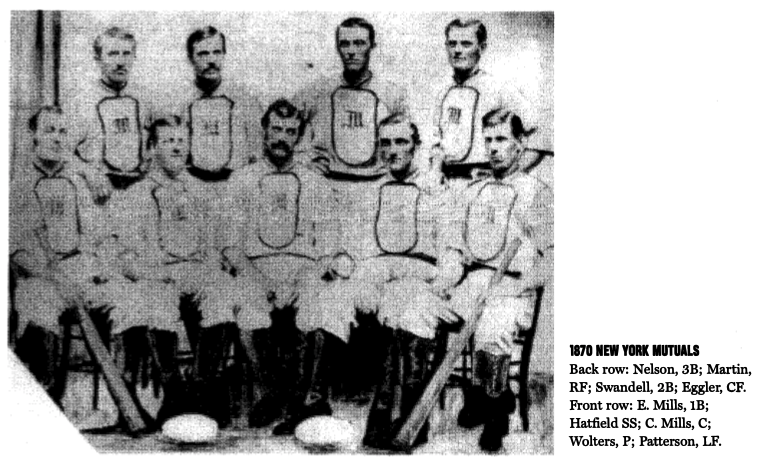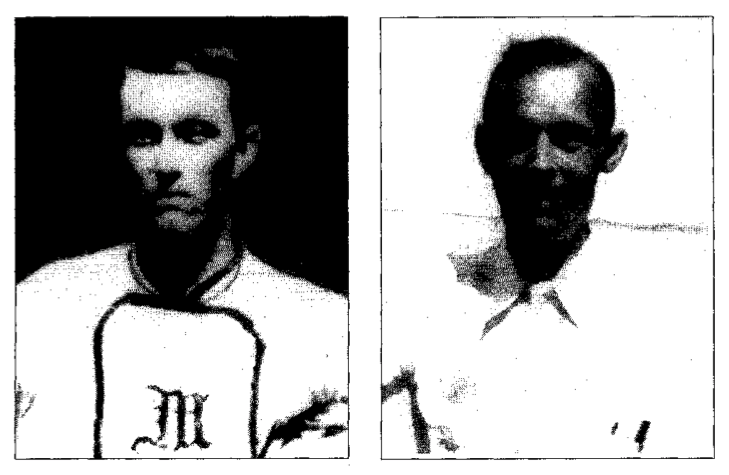Identifying 19th-Century Player Dick Higham … Perhaps!
This article was written by Harold Higham
This article was published in 2002 Baseball Research Journal
Because it seemed both helpful and important to attempt to round out Richard “Dick” Higham’s story (see TNP 2000 and TNP 2001) with photographs, I researched libraries, archives, newspapers, and magazines, etc. Identifying 19th-century baseball players in 19th-century photographs can be trying. Finding such pictures and attempting to determine whether you have actually succeeded in identifying the players depicted in them can be both exasperating and elating. However, the exercise below may, hopefully, offer some encouragement to those who would undertake a similar task.
Since I do not have a family photograph of Dick Higham for a direct comparison, it became necessary to weigh the credibility of what was found. In addition, just viewing and comparing one picture to another is not sufficient. For each photo, I had to consider the source, condition when found, available historical background, and possible comparisons of the team and/or other individual players depicted, of each. When making simple comparison of Higham as depicted in one photo with another, I also used techniques suggested to law enforcement agencies.1
While these are for the most part forensic considerations, it was also most helpful to engage in discussions with fellow researchers. I located photographs of four teams on which he was a member, taken during his playing career, 1870 through 1880, at the time he was a member of each. Two of them name him, one of them does not identify anyone depicted, and the last one, I believe, misidentifies him as another player. The photographs are of the 1872 Lord Baltimores,2 the 1877 Syracuse Stars,3 the 1876 Hartford Dark Blues,4 and the 1870 New York Mutuals.5 It appears each was taken inside a photographer’s studio. The results can be described as being anywhere from “murky” to “rather clear” to “I know it’s him, for sure.”
1872 LORD BALTIMORES
This is the earliest photograph which identifies a pictured player as Dick Higham. He would have been 21 years of age when it was taken. SABR member James Bready, who has published it more than once, has told me that he acquired the photograph from the Baltimore Public Library, but when he did, someone had already placed the names of the players on its face.
In this photograph it appears the light source used was stationed on the extreme right. Drawing an imaginary vertical line down the middle of the photograph, note the dark shadows, in particular, on the right corner of the backdrop and on the faces of the five players on the right. Those on the left have softer shadows and some have less defined features. The figures of Higham and Hall have the least clarity, with flatter faces and seemingly bulging eyes.
For the purpose of making comparisons with the following photographs, assuming the figure identified is Dick Higham, our benchmark is a “narrow” face, with “medium lips” and “close ears.” As an example of others’ attributes, Tom York and Bobby Matthews can be said to have “narrow” faces with “medium” lips but “out” ears. William Craver can be described as having a “narrow” face, “medium” lips and “medium” ears.
Close-ups of the Higham face and of the figure alone have been used by SABR to accompany two previously published articles6 concerning Dick Higham. However, as I recollect the men on my father’s side of the family all having black or dark hair, I would have to question whether it is him. Of course, the photograph may have been taken by an inept photographer with poor equipment and/or due to harsh handling of the photograph itself, over time, his hair may have become lightened. Finally, someone may have simply made a mistake when affixing the players’ names.
1876 HARTFORD DARK BLUES
No player in this photograph was identified anywhere on it. It was necessary to compare this photograph with a photograph of the 1875 Hartford Dark Blues,7 on which the players’ names appeared. Fortunately, the rosters of the two teams were the same in almost all respects for both years (note also Captain Bob Ferguson’s location) except for the addition of Dick Higham in 1876. The 1875 photograph pictured ten players, and the 1876 photograph pictured the same ten plus one. Mark Rucker, who had previously published the 1875 photograph, with the players’ names, and to whom I sent a copy of the 1876 photograph, generally agreed with the above identifications.
The photograph is actually taken from a “Base Ball Carte,” a copy of which had to be enlarged and digitally restored. Viewing the actual “Carte” from right to left shows increasing marring, scraping and dirt which consequently the restorers had to deal with as best they could. Note the seated players on the right side are the clearest and the two standing in the back remain somewhat blurry. Interestingly, in this photograph Tom Carey’s features are better defined, and both Tom York and Dick Higham, at least in 1876, now parted their hair in the middle. The Dick Higham figure once again has a “narrow” shaped face, “medium” lips, and “close” ears. He would have been 25 years old here.
1877 SYRACUSE STARS
This is the second photograph in which he is named. It is the clearest of all the photographs I have been able to locate. He would have been 26 years of age at the time. SARR member Ron Gersbacher, who told me about this photograph, believes he is accurately identified as the third player from the left sitting down. Ron relies not only on the names as found on the back of the photograph, but also a common practice of the day to sit the captain of the team, which Dick Higham was in 1877, in the middle row close to the center of a team photograph.
As opposed to the previous photograph, here he is sitting in a chair instead of on the floor, his arms are folded and he is wearing a team cap. I would not venture to say that the bit of hair showing by his left ear, from under the cap, clearly shows he had dark hair. However, the face, lips, and ears appear the same as above. I would believe this is a picture of Dick Higham.
1870 NEW YORK MUTUALS
When I first saw a copy of this photograph, dated only “1870s” on its reverse, at the Hall of Fame and Museum in Cooperstown, I felt an error had been made. I knew the player identified as Swandell could not be anyone else but Richard “Dick” Higham. This was evident to me, at that time, because the pictured player so closely resembles my grandfather, his son, Harold Higham. In this picture he is 19 years of age.
To confirm it was indeed a picture of him required a bit of extra digging and help. I needed to not only date the photograph, if possible, but also to demonstrate he was a member of the team at that time, that the player named could not be the one pictured, and that the one pictured could be him. I believe I have succeeded. As you can guess, I do not even have a comparison photograph of Marty Swandell on which to rely.
An important clue came from SABR member David Nemec. He pointed out in correspondence concerning the picture that C. Mills (Charlie) and E. Mills (Everett) were misidentified, each referred to as the other. Charlie Mills last played for the Mutuals in 1872, which means the photograph must predate 1873. In addition, Everett Mills, who also appears in the pictures of the 1872 Lord Baltimores as well as the 1875 and 1876 Hartford Dark Blues, did not play for the New York Mutuals in 1871 or later.8 Therefore, the photograph could not have been taken after 1870.
John Martin “Marty” Swandell was on the 1870 roster of the New York Mutuals. Richard “Dick” Higham had begun the 1870 season with the Morrisania Unions, but later came over to play for the Mutuals. The first game in which Dick Higham played for the Mutuals took place on September 24, 1870, in Trenton, New Jersey. He played third base and Marty Swandell was at second base. This infield combination continued for three more games. On October 26, against the Red Stockings, Swandell was not in the lineup and Higham played second base. Swandell returned for only one more game that season, on November 10 against the Athletics. When Rynie Wolters did not appear, “Phoney” Martin was moved to pitcher, Swandell took center field, and Dick Higham remained at second base.9
The above photograph also shows that the player standing second from the right is not quite as tall as the first player on the right. Dave Eggler, the player on the right, was reportedly 5’9″ tall.10 The player on the team that year who comes closest to that height with out being quite as tall is Dick Higham at 5’8 1/2″. Marty Swandell’s height has been reported as being at least 5’10 1/2″. If Swandell were standing next to Dave Eggler, the difference of one and a half inches in height would be readily apparent. In addition, while Dave Eggler played with the New York Mutuals through 1873, Marty Swandell did not play for the New York Mutuals after 1870.11 Therefore, it appears the picture was probably taken no earlier than July 31, 1870 and no later than the end of that season.During this time frame Dick Higham had joined the team and Marty Swandell never played for them again.
Last, below is an exhibit of a photographic comparison of a close-up and enlargement of the face of the player standing second from the right in the Mutuals’ photograph and that of my grandfather Harold Higham, taken at about age 42. I suggest this comparison seals it.
DOUBLE PHOTOGRAPH
When I brought the photograph of the Mutuals and one of my grandfather to a photographer’s shop for the comparison work to be performed, the technician upon viewing the side-by-side comparison photo graph as it came out of the machine remarked: “The difference between the two pictures is that in the first one he’s not smiling and in the second one he is.” To which I replied: “The real difference is the gentleman on the right is the son of the gentleman on the left!” Hopefully, with this article and the two previously published in The National Pastime taken as a whole, the reader has the fullest biography of Richard “Dick” Higham, one of major league baseball’s earliest great players and umpires, as can be presently assembled.
History, as it always does, discloses more and more of itself as we continue to review and critically question the available record as it is uncovered. So is it also with our national pastime, its participants, observers and fans alike.
HARRY HIGHAM is a great-grandson of Dick Higham and has been a SABR member since 1997. He studies 19th century Base Ball and umpires vintage baseball games.
NOTES
1. McDonald, Hugh C., The Classification of Police Photographs. Los Angeles: De Voss & Co., 1941: 18, 23, 39, 59.The primary classification is height, which in this analysis will play a part, but because of the poses in some of the photographs will not be totally helpful. The secondary classification of face, here narrow shape, medium lips, and close ears, described in the main piece, will be most helpful. As no side view is presented, the profile and nose classifications are not available. Likewise for obvious reasons, color of eyes can not be utilized. Throughout, the reader should keep in mind, “the final classification of the hair, the build, and the complexion or color …while important, will be considered as having less importance. … The reason for this lesser degree of importance lies in the fact that these three characteristics are likely to change radically over a comparatively short period of time.”
2. Bready, James H., Baseball in Baltimore. Johns Hopkins Univ. Press, 1998, Baltimore: 19. A drawing of the team members as it appeared in the New York Clipper that year appears on page 16.
3. This photograph is from the collection of the Baseball Hall of Fame and Museum at Cooperstown, New York.
4. This photograph is from the Archives of the Connecticut State Library in Hartford, Connecticut, and Baseball Hall of Fame and Museum at Cooperstown, New York.
5. This photograph is from the Spalding Collection of the New York Public Library. A comparison of this photograph with the one which appears in America’s National Game, (Spalding, Albert G. Univ. of Nebraska Press, Lincoln, 1992), p. 164, show the latter to have been sharpened in player and uniform definition. This was a common practice for advertising and distribution purposes. The copy shown in this piece would be the original as it was taken. The reader will also note the lack of the appearance of the legs of the four players standing in the rear, which is due to the fact that the team was posed behind a front drop through which they poked their heads and hands and on which their uniforms as well as their bats and hats were drawn. For similar example, see a photograph of the 1876 St. Louis Grays, on page 88, of The Great Encyclopedia of 19th-Century Major League Baseball, Nemec, David. New York, Donald I. Fine Books, 1997.
6. Baseball’s First Stars, Frederick Ivor-Campbell, Robert L. Tieman, Mark Rucker, eds. Society for American Baseball Research, 1996, p. 77; and The National Pastime, Society for American Baseball Research, 2000, p. 23.
8. Rucker, Mark, Base Ball Cartes, Transcendental Graphics 1988, p. 58.
9. Total Baseball, Seventh Edition, John Thorn, Pete Palmer, Michael Gershman, eds. New York: Total Sports Publishing, 2001. 1020.
10. New York Times, October 26, 1870. New York Clipper, November 5, 1870. An item published in The Fireside Book of Baseball, Charles Einstein, ed. Simon and Schuster, New York, 1956, pp. 46-47 purports to be Henry Chadwick reporting on a game between the Red Stockings and the Mutuals held on October 26, 1869, in which Higham replaced Swandell. If this were true, it would appear the Higham/Swandell substitution took place twice in two different years. The item is taken from Chadwick Scrapbooks, Vol. 1-6, Spalding Collection, New York Public Library. Reading that entry on microfilm reveals that it can not be identified by newspaper or date of publication on its face. Rather, it appears the editor of the scrapbooks, perhaps Henry Chadwick himself, placed the notation “69” on the artifact in pen and ink, and it was taken as the year of publication. The New York Times does not report any base ball game in 1869 as having been played anytime from October 24 through the end of the month. An actual reading of the 1870 New York Clipper edition, dated November 5, contains Chadwick’s Wednesday, October 26, 1870, report of the game.
10. For comparison purposes, see a later picture of Dave Eggler, p. 168 of America’s National Game.
11. Total Baseball, p. 1,216.



